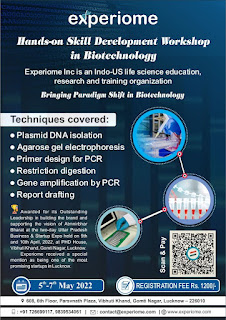Experiome | Summer Training in Biotechnology and Bioinformatics
Experiome | Summer Training in Biotechnology and Bioinformatics
CRISPR-Casuse to meet the need of Vitamin A
Nutrition is essential for healthy growth and development. Macronutrients or micronutrients are the two types of nutrients. Requirements of macronutrients including fats, proteins, and carbohydrates are relatively higher to that of micronutrients including several vitamins and minerals. In comparison, if the amount of micronutrients in the diet is low, it has an impact on the child's physical and mental development.
Vitamin A is a lipid-soluble vitamin that
is required for cell growth, metabolism, immunological function, eyesight, and
reproduction. It is absorbed in the duodenum and stored in hepatic stellate
cells, as well as in adipose tissue and the pancreas in small amounts. Vitamin A
is found naturally in dark leafy greens, orange-colored vegetables, milk
products, liver, and fish. Vitamin A intake should be around 200 micrograms per
day for children aged 1 to5, 700 micrograms per day for women, and 900
micrograms per day for males.
Vitamin A deficiency is a source of
concern for children in impoverished countries. According to UNICEF, one-third
of children do not receive vitamin A supplementation, while the WHO estimates
that 190 million pre-school children are vitamin A deficient. According to a
survey conducted by the National Nutrition Monitoring Bureau (NNMB), around 62
percent of preschool children in India have Vitamin A deficiency, and 21.5
percent have serum retinol levels of less than 0.35 mol/l.
Considering the scenario, biotechnologists
areattempting to enhance the Vitamin Acontent by using clustered regularly
interspaced short palindromic repeat (CRISPR) technology. Banana is
economically important fruit throughout the world. Genetically modified crops
with the help of CRISPR-Cas are found to be promising. Recently, the
carotene-rich Cavendish banana cultivar (cv.) Grand Naine was developed using a
CRISPR/Cas9-based method (AAA genome). The lycopene epsilon-cyclase (LCYε)
gene's fifth exon was targeted. Designed guide-RNA’s targeting specificity was
also tested by its capacity to develop indels in the LCYε gene in cv. Rasthali
(AAB genome) genome. In comparison to control (without genome editing) plants,
metabolic analysis of the fruit pulp of the chosen edited lines revealed a 6-fold
increase in beta-carotene concentration (24 microgram/g). Enhancing the quality
and the content of the fruit via CRISPR could be a potential alternative for the
population suffering from Vitamin A deficiency.
We, at Experiome, offer training in CRISPR-Cas
vector designing. We provide bioinformatics support for CRISPR-Cas vector
design for any gene of interest.

Comments
Post a Comment